What is houseplant drainage and what can it be made of?
When planting a houseplant, experienced florists always use drainage. It is placed at the very bottom of the flower pot, and sprinkled on top with fertile soil substrate. Many beginners are wondering: what is drainage for indoor plants, what is it for, what is important for the development and growth of a green pet. Therefore, before the transplant procedure, it is recommended that you familiarize yourself with the types and properties of the material.
Content
- What is drainage and what is it for?
- Drainage types and their features
- How to properly drain?
- What are drain holes?
- What cannot be used as drainage?
What is drainage and what is it for?
For the normal and fruitful growth of indoor plants, certain living conditions should be reproduced. In order for a flower to please with its appearance, it needs a well-developed root system... To accomplish this, it is necessary to select a high-quality soil substrate. The composition of the soil should contain at least 50% of solid particles, about 15% of the required oxygen and up to 35% of the nutrient fluid. Thanks to the prepared drainage system, according to the requirements, the stated condition can be fully met.
This is due to the fact that in the absence of drainage during watering, the required oxygen density is displaced, which should optimally saturate the pet's rhizomes. If there is no oxygen in the soil substrate, and moisture, on the contrary, stagnates for a long period, then the plant is threatened with the appearance of pathogenic fungal and not only bacteria that stimulate the occurrence of diseases. Additionally, without the necessary system, the soil substrate is gradually subject to compaction, it dries out unevenly, which leads to excessive watering.
Drainage is a system that drains the soil substrate, maintains the optimal amount of nutrient moisture contained in the soil and eliminates the prerequisites for the development of pathogenic bacteria.
Due to the placement of an additional layer, excess water is removed from the soil after irrigation, it does not stagnate. In addition, nutrient air enters through the lower drainage holes and cavities, saturating the root system and contributing to the good development of the ground part.
Drainage types and their features
As a drainage of the earth for a flowerpot, any material of a coarse fraction that is not able to enter into an adverse reaction with nutrient moisture and introduced dressings is suitable. Such material should not swell, not crumble, be resistant to decay or compaction, but at the same time it should be good for water to pass through itself.
The most optimal drainage options are distinguished:
- Expanded clay - is an environmentally friendly material and the most popular substance used to drain the soil when planting indoor plants. It is freely available and sold at a normal cost in any flower shop.Its main advantage is the presence of clay in the composition, which copes well with the transmission of nutrient moisture. If necessary, you can pick up a slightly larger fraction and a fairly small diameter. A large volume is perfect for large flowerpots and tall indoor plantings. If a small fraction is placed in such a pot, then there is a possibility that the material will get stuck in the drainage holes and block the outlet for excess water. Therefore, it is worth considering what is the appropriate option to choose for a specific container size for planting flowers. The advantage of this kind of drained system is the moment that expanded clay will never swell or dry out, but after 5 years it is recommended to replace it.
- Perlite or vermiculite - such substances only have a beneficial effect on the planted sprout. Vermiculite externally has a specific appearance and vaguely resembles shavings. Perlite, in turn, is small granules with a grayish tint. Such a drainage system perfectly absorbs moisture, and when the soil substrate dries up, it gives it away. This allows you not to water the plant for a long period of time. The only drawback of both means is its price - not all gardeners can afford the cost of the substance.
- Ceramics - Broken ceramic dishes become an excellent option for delivering oxygen to the root system and removing excess liquid from the soil substrate. In the days when there were no plastic containers and flowerpots, only ceramic pots were used. They allowed the roots to breathe and removed excess moisture, eliminating the possibility of the development of pathogenic bacteria and pests. Now this kind of tableware is used in the form of broken fragments, laid out with the convex part down. To improve the effect, gardeners advise placing 5 cm of river sand on top.
- Charcoal is an excellent substance for soil drainage. Coal absorbs nutrient moisture well and releases it when the soil begins to dry out. In addition, charcoal has antiseptic properties, which allows you to get rid of any type of disease developing in the earth. The only drawback of coal is that it quickly dissolves in the soil, but at the same time saturates the soil with nutrients.
- Sphagnum moss - a facility that has all the requirements for the implementation of the drainage system. But to use it, you need to tinker: until it is laid on the bottom of the flowerpot, it is pre-soaked in liquid for 30 minutes. This is necessary so that the moss is properly saturated with moisture. Only after the manipulation has been carried out, the substance is placed in a pot and the plant is rooted. It is required to store natural material in a cool and humid place, but in no case in a plastic bag.
- Brick - any material can be easily replaced with broken brick. This substance is of natural origin, therefore it only has a positive effect on plants. But before laying out the broken fragments, it is required to sharpen the edges so that the young roots are not damaged by the structure of the auxiliary tool.
- Crushed stone or gravel - can fully replace any drainage. But the disadvantage is the considerable weight. Therefore, this condition should be taken into account when deepening the seedling.
Thanks to the variety of excipients, you can choose any suitable material for planting your indoor green pet and enjoy its magnificent growth.
How to properly drain?
When a plant is planted in a new place of residence when buying in a store, when transplanting or when root diseases develop, the drainage layer must be replaced with a new one. If stone chips or expanded clay are used as a drainage system, then they can be washed under running water and kept in a weak potassium permanganate solution... Then dry and further apply to other flower crops.
When rooting a young seedling or an adult plant, the layer of the drained system should be selected under the shrub. If the optimal drainage size is not specified in the planting conditions for a particular seedling, then it is required to use either the minimum layer or the middle one. For precise directions for a particular crop, the recommendations should be followed. The minimum layer size is 1-3 cm, the average one reaches 5 cm and the high one is from 5 cm and more, with large flowerpots it can reach up to 15 cm in height.
The height of the material layer is influenced by the drainage holes and the height of the flowerpot.
If the holes in the bottom are numerous and of medium size, then the drainage can be laid out in the size of 1-3 cm, if one hole in the middle is up to 5 cm. At the time of the rooting procedure, the quality of the items used should be monitored. The substance should be poured before the very event of placing a young sprout in a new flowerpot. To eliminate the possibly formed empty cavities, the pot needs to be shaken a little and tapped from the sides so that the expanded clay or crushed stone becomes evenly, filling the entire plane.
What are drain holes?
For rooting young seedlings or adult plants, plastic flowerpots are produced. They are easy to handle and cheap. But if earlier clay and ceramic flowerpots were distinguished by excellent air permeability and moisture absorption, then plastic containers do not provide such an opportunity.
Moreover, if the flowerpot is solid, then the stay of the green pet in it is not durable - the plant will quickly begin to wither, the water stagnates, and eventually fungal diseases and mold on the roots form. This is due to the fact that the plastic container comes without special holes. The necessary holes are only outlined in it, but they need to be additionally punched or cut into the required number and diameter.
For each plant, a separate size and number of drainage holes should be selected:
- For succulents, drainage holes should be made larger and larger.
- For phalaenopsis and orchids - identical requirements as for succulents are suitable. In addition, additional holes must be made in the side walls of the flowerpot for a better respiratory process.
- Moisture-loving shrubs - drainage holes are also made for them, but of small diameter and not in significant quantities.
It is impossible to determine the accuracy of the number of drainage holes for each individual flower. To select the optimal pot that allows for a high-quality drainage system, it is necessary to take into account such characteristics as the age of the plant, the volume of the flowerpot and the size of the seedling.
What cannot be used as drainage?
When carrying out preparatory work for rooting a seedling, many gardeners make a number of mistakes. First of all, improperly selected drainage is a common problem for the further growth of the shrub, which is prohibited to use for the layer as drainage of the earth:
- Sand - not only does it not drain water from the soil, but on the contrary, it retains, nourishes and even more creates conditions for the multiplication of fungal infections.
- Nut shells, tea leaves, tree bark or egg shells are natural products. They may contain pathogenic microorganisms that provoke the formation of pathogenic bacteria, and also attract harmful insects.
- Crumbs of marble and granite - this material tends to enter into a chemical type of reaction, which leads to a change in the acid-base balance of the soil. Subsequently, if the optimal pH level is violated, there is a possibility of growth retardation or complete loss of the seedling. It is imperative that when removing excess moisture, it should be removed from the pallet. Prolonged stagnation of the nutrient fluid will lead to the attraction of pests, which will negatively affect the plant.
Thus, before planting a plant, you should familiarize yourself not only with the principles of rooting a pet, but also carefully study the purpose of drainage, its possible types. In addition, it is recommended to make the appropriate holes at the bottom of the flowerpot, which are optimal for the planted seedling.
More information can be found in the video:



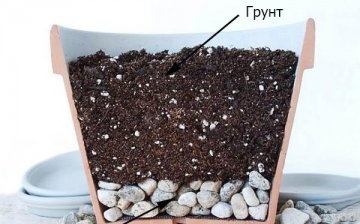
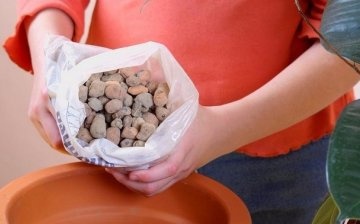
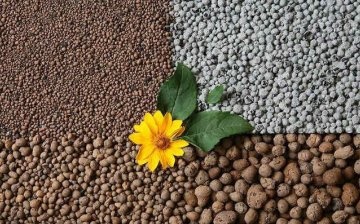
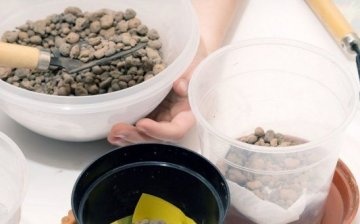
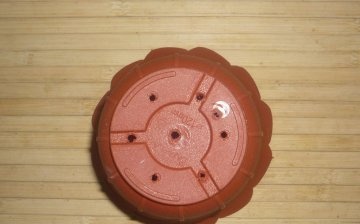







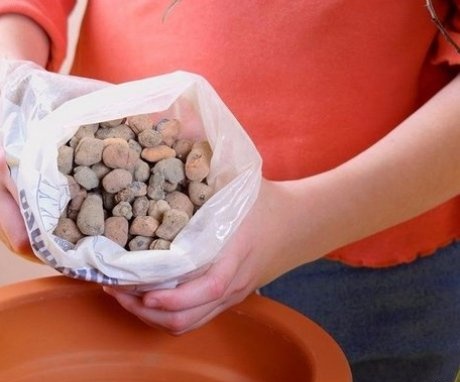

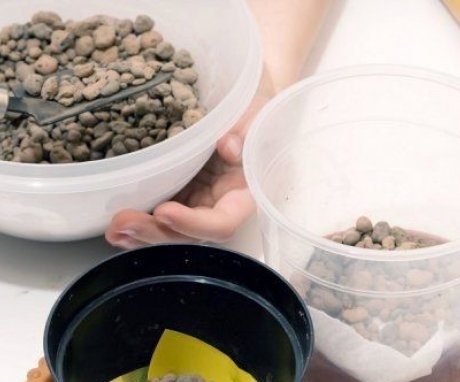
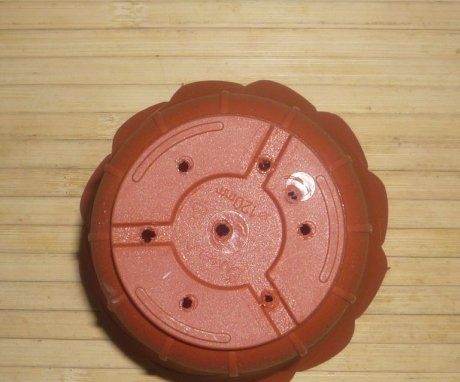

For drainage, my mother and I collect any pebbles that we find on the street and actively use them when transplanting plants from one pot to another. But we try not to take gravel.
I always used only expanded clay when transplanting indoor plants, I did not even know that you could still use broken brick, crushed stone, gravel or even moss. This is a great discovery for me.
Lera1, why do you try not to take gravel?
I use only purchased material for drainage, for example, expanded clay. It is safe for my flowers, and I am always very worried so as not to harm them, as I invest a lot of time and effort in caring for indoor plants.
You can also use scarlet walnut, which is also an environmentally friendly material. I also used styrofoam, broke it into pieces and on the bottom of the pot, poured earth on top.
I use special granules (sold in the store), something like porous expanded clay. I also use granules that retain moisture and give it to the plants gradually. You can water it "powerfully" once a week instead of every three days.